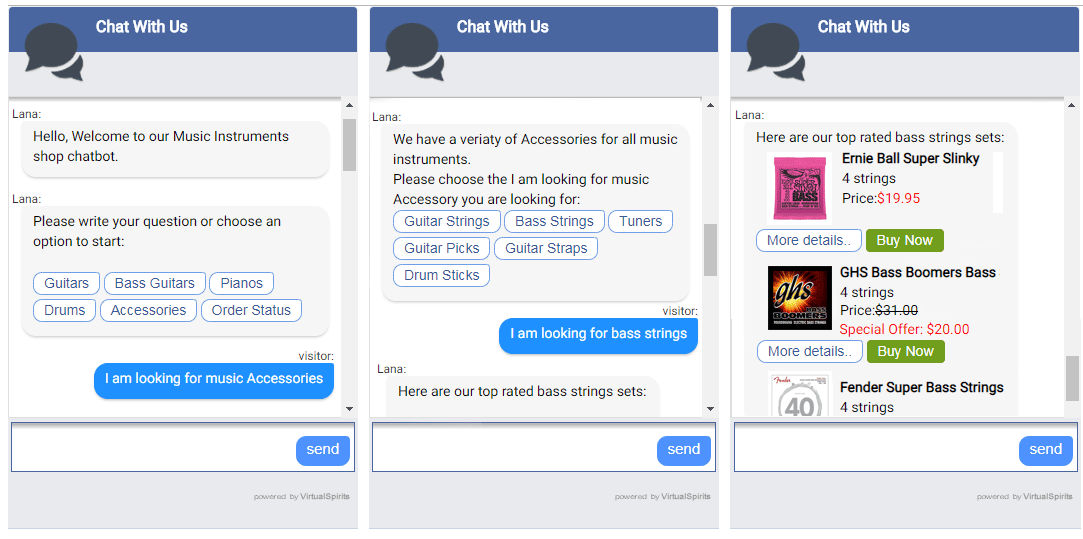
TOPICS:
Chatbot for Ecommerce Chatbot for Service Chatbot Optimization
Chatbot for Ecommerce Website – How to Save Sales and Solve Customer Problems
Maximizing sales while simultaneously minimizing customer issues has forever been the holy grail for ecommerce businesses. Now, with chatbot for ecommerce website, modern online stores are making steady progress towards that once-elusive goal. Building ecommerce website chatbots and optimizing them for your online shopping website is a straightforward and inexpensive exercise, especially when you choose the right chatbot platform. In this article, we’ll take you through the process of securing sales and solving customer problems with the help of ecommerce chatbots.

1. Saving your customers’ time:
Studies reveal that mobile app download rates have gone down sharply since 2016, indicating that the app boom may be over. Mobile internet usage patterns tell a similar story. Browsing sessions are shorter than they used to be in the early 2010s, and millennial online shoppers are constantly on the lookout for options that can speed up their buying process. This is a big reason why chat tools have caught on so much in the field of ecommerce.
As an online store owner, you can create an ecommerce chatbot to get your visitors’ attention in those critical first few seconds that they spend looking around your store. Because shoppers have come to expect a chat window on most ecommerce sites, you’d be missing out on potential sales and signups by not having one in place.
2. Maintaining customer loyalty:
All ecommerce businesses – big and small – struggle to build customer trust and loyalty. Buyers and sellers don’t actually know or see each other during an online transaction, which is why it’s generally difficult to establish trust between them. But building chatbots for ecommerce websites offers a convenient workaround. Because when you create a chatbot, you also create a connection between your store and your buyers.
Let’s say yours is an online sportswear store, and Jessica, a potential customer, drops by looking for training shoes. When she arrives at your website, she sees a chat window bearing a friendly greeting: “Welcome to ABC Sportswear. What can I help you with?”
Jessica just needs to tell your chatbot that she’s looking for training shoes, and the bot can take it from there, personalizing her search experience by asking her relevant questions like:
“Do you have a brand preference?”
“Are you looking for shoes compatible with specific activities? Choose one or more of the following: tennis, walking, running, aerobics, cross-training.”
“Do you have a preferred budget?”
Once Jessica has selected a pair of shoes, your chatbot is again available to answer her questions about shipping, delivery and returns.
Jessica: “What is your return policy in case I want to return these shoes?”
Chatbot: “You can initiate a return within 15 days from the delivery date. We will arrange for the product to be picked up from your address, and issue you a refund if the product is received in its original (unused) condition with tags intact. To read more about our return policy, click here.”
Even after making her purchase, Jessica knows she can contact your chatbot to track her shipment, or reschedule the delivery. In fact, the chatbot can present her with a menu of options like “Where’s my shipment?”, “How do I return my order?”, “Change delivery time slot”, and so on, getting her the information she needs in a single click.
Each of these interactions helps your store make and maintain a positive impression on Jessica. The personal attention that she gets from the ecommerce chatbot helps her trust your business, and keep it in mind the next time she needs new sports gear. The fact that she doesn’t know the sellers on your site doesn’t matter as much, because you seem to be on top of the purchase, shipping and returns process.
3. Dealing with shopping cart abandonment:
Shopping cart abandonment turns out to be a particularly tricky challenge for online stores. But getting customers to complete their purchase is one of the biggest benefits of building chatbots for ecommerce websites. An online chatbot is up and about during those crucial moments when a customer decides to postpone their purchase or move on to another store in search of better prices. The chat window is in fact the only ‘live’ communication channel between the store and the customer at such times. Which is why ecommerce businesses often use their chatbots to offer discounts or helpful information to encourage customers to go through with their orders.
In our recent example, if Jessica seems to hesitate or click around after adding the training shoes to her shopping cart, the chatbot could come up with something like:
“Sale alert! The items in your cart are eligible for a 10% discount. Use [Coupon Code] during checkout to avail this limited period offer.”
And Jessica would be tempted to go through with the purchase after all.
4. Getting to know your customers better:
Sure, an ecommerce chatbot does a lot of good as a friendly ‘concierge’ or virtual shop assistant. But its behind-the-scenes efforts also come in handy for online store owners. Building chatbots gives ecommerce businesses vital insights into their customers’ needs, preferences, and behavior.
Unlike standalone market research or other static studies, chat transcripts provide real-time information about your customers, showing you what they’re currently asking for, what they like about your website, products or services, and what’s preventing them from completing their purchases. You can then use this information to upgrade your chat script and give them the information and solutions they’ve been looking for. This leads to a steady stream of happy customers, getting you measurable improvements in your sales figures in a relatively short span of time.
A lot has been going on in the field of ecommerce chatbot development. Find out on our blog, or talk to us if you’d like to create a chatbot for your own online shopping website.